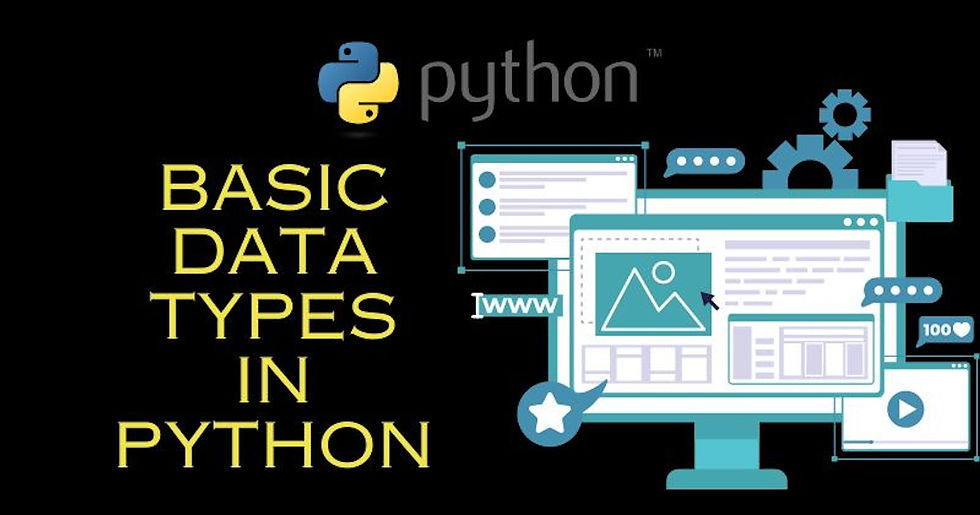Understanding the Different Types of Functions in Python Programming Language
- offpagework1datatr
- Mar 30, 2024
- 3 min read

Python, a versatile and popular programming language, offers a rich set of features to developers. Functions in Python are fundamental building blocks that encapsulate a set of instructions to perform a specific task. Understanding the various types of functions in Python is crucial for effective programming and code organization. In this comprehensive guide, we will delve into the different types of functions in Python, exploring their characteristics, applications, and best practices.
1. Built-in Functions:
- Python comes with a plethora of built-in functions that are readily available for use without the need for any additional imports.
- Examples include `print()`, `len()`, `range()`, `max()`, `min()`, `sum()`, and many more.
- These functions serve common tasks such as I/O operations, mathematical computations, data manipulation, and type conversion.
- Built-in functions significantly enhance productivity by providing pre-defined functionalities, reducing the need for writing repetitive code.
2. User-defined Functions:
- User-defined functions are functions created by the programmer to encapsulate specific tasks or operations.
- These functions promote code reusability, modularity, and maintainability.
- A user-defined function typically consists of a function header, parameters (optional), function body, and a return statement (optional).
- By defining custom functions, developers can abstract complex logic into manageable chunks, enhancing code readability and organization.
3. Anonymous Functions (Lambda Functions):
- Lambda functions are small, anonymous functions defined using the `lambda` keyword.
- They are primarily used for short, simple operations where defining a full-fledged function is unnecessary.
- Lambda functions can take any number of arguments but can only have one expression.
- Commonly used with higher-order functions like `map()`, `filter()`, and `reduce()` for concise and expressive functional programming.
4. Recursive Functions:
- Recursive functions are functions that call themselves directly or indirectly to solve a problem.
- They follow the concept of divide-and-conquer, breaking down a problem into smaller, more manageable subproblems.
- Proper termination conditions are crucial to prevent infinite recursion.
- Recursion is particularly useful for tasks involving tree structures, factorial calculations, and mathematical operations like Fibonacci series generation.
5. Higher-order Functions:
- In Python, functions are first-class citizens, meaning they can be passed as arguments to other functions and returned as values from functions.
- Higher-order functions either take one or more functions as arguments or return a function as a result.
- Examples of higher-order functions include `map()`, `filter()`, `reduce()`, and function decorators.
- They facilitate functional programming paradigms, enabling elegant solutions for tasks involving data transformation, filtering, and aggregation.
6. Generator Functions:
- Generator functions are special types of functions that yield a sequence of values one at a time instead of returning them all at once.
- They use the `yield` keyword instead of `return` to generate values lazily, conserving memory and improving performance.
- Generator functions produce values on-the-fly, making them suitable for processing large datasets or infinite sequences.
- Iteration over generator functions can be done using a `for` loop or by passing them to functions that consume iterables, such as `list()` or `next()`.
7. Closures:
- Closures are functions that remember the environment in which they were created.
- They retain access to variables from their enclosing scope even after the outer function has finished execution.
- Closures are created when a nested function references variables from its enclosing scope and is returned from the outer function.
- They are useful for creating factory functions, maintaining state across multiple function calls, and implementing callbacks.
Conclusion:
Understanding the different types of functions in Python is essential for mastering the language and writing efficient, maintainable code. Whether it's leveraging built-in functions for common tasks, defining custom functions to encapsulate logic, or employing advanced concepts like lambda functions, recursion, and closures, Python offers a wide array of tools to meet diverse programming needs. By exploring and utilizing these various function types effectively, developers can enhance productivity, readability, and scalability in their Python projects.



Comments